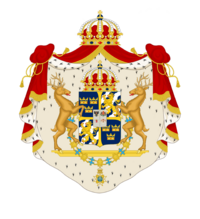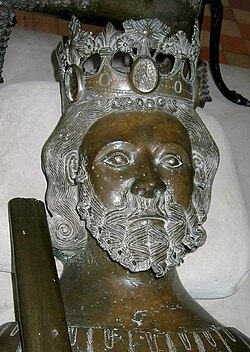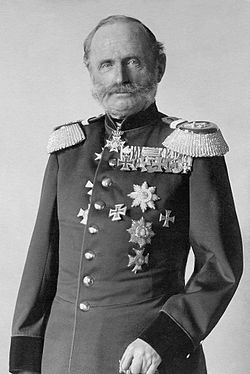House of Eirikr
| House of Eirikr Hus av Eirikr House of Kveldling House of Hrudolfung | |
|---|---|
| Royal house | |
 | |
| Country | Emerstari |
| Current region | Scania |
| Etymology | from Erik I |
| Place of origin | Kingdom of Flodland |
| Founded | December 25, 726 |
| Founder | Erik I of Emerstari |
| Current head | Erik XII Georg of Emerstari |
| Titles | |
| Members | Ailigean III Erik XII Georg James VI Kjoste II Aadolf Willem IX |
| Connected families | House of Leijonhuvud House of Potois |
| Traditions | Lutheranism |
| Motto | God, Åra, Rett (God, Honor, and Right) |
| Estate(s) | Midtenflodplats |
| Cadet branches | |
The House of Eirikr (Emerstarian: Hus av Eirikr) is an Emerstarian dynasty which has more or less continuously held the throne of the Kingdom of Emerstari since its creation in 1047. Dynastic marriages, especially of the children of the "Grandfather of Scania" Erik VIII Olaf, led the family to expand its domains throughout the Scanian peninsula. Due to the consolidation of Scania in the nineteenth century, however, members of the House of Eirikr and its cadet branches reign in only six countries today: Canaria, Eilben, Emerstari, Ingelland, New Retermi, and Soumeland.
As a result of cognatic lines and bastards, there are several cadet branches of the House of Eirikr, some of which are either extinct completely or have no surviving agnatic lines, such as the House of Håkonung, the House of Margretning, and the House of Ljungeting. Cadet branches which still have direct male lines descending from Eirikr, and thus Kveldur, include the House of Ergoisme, the House of Eirikr–Kóhenny whose members currently reign in Eilben, the House of Malmø whose members reigned in Emerstari from 1250 to 1270 and again from 1303 to 1370, the House of Mounsing whose members currently reign in Ingelland, the House of Munso, the House of Klegge–Ljungeting, the House of Schlaussen, and the House of Sverrer whose members reigned in Emerstari from 1416 to 1421. The Duke of Ekkesburg, Thomes Adulf Lorenssen–Eirikr, a direct male-line descendant of Eirikr's brother, Bjarnvaldi of Ekkesburg, layed claim to the throne of the Green Union in 2036.
History
Origins
The House of Eirikr was not called such until some time after the unification of Emerstari by its current namesake Eirikr Segersælla. Rather, it was identified as the House of Kveldling, for the eighth century High Chieftain of the Hrudolfling Clan, Kveldur, who brought together the Hrudolfling, Ullerung, Hervalding, and Einarung Clans to form the petty Kingdom of Flodland. According to Emerstarian tradition, Kveldur is the fourteenth great grandfather of Eirikr and is himself, a direct male-line descendant of Hrudolf for whom the Hrudolfling Clan. Hrudolf, in turn, is according to Emerstarian tradition, one of the earliest inhabitants of Emerstari and a descendant of Noah's through his son, Japheth, and grandson, Magog.
Kingdom of Emerstari
Upon the death of Erik I of Emerstari in 1078, he was succeeded by his sons Jakob and Olaf who ruled as diarchs as a result of the Council of Uppsalle held in 1075. Jakob I died in 1085, but the Second Council of Uppsalle held in 1084 determined that there would be no further diarchs after the death of Olaf I and that, as Jakob was the eldest son of Eirikr, kingship would pass to his children. Jakob's eldest son, Jakob II "the Chastite" had, however, taken vows of chastity to the Church—although some historians suggest this may have been to cover up the fact that he may have been altogether infertile—and did not produce an heir. Olaf used this as a reason to persuade many of the Emerstarian nobles to accept his own son, Karl as heir to the throne of Emerstari. Therefore, in stark contrast to that which many of the same nobles agreed upon at the Second Council of Uppsalle, upon Olaf's death in 1105, Karl I was crowned diarch of Emerstari. When Jakob "the Chastite" died of food poisoning in 1112, his brother Naef, who had lost favor among the nobility even before his disheritance, attempted to seek foreign support in his claim for the throne. Naef was subsequently exiled to the Halleran Islands, only allowed to return during the rule of his nephew in 1124.
Karl I's son, Eirik "the Bear", was only seven at the time of his father's death, so as to avoid the rule of a child, the nobility disinherited him from the kingship. He still inherited the Duchy of Flodland, however, as it was considered the family's ancestrial lands. As Eirikr's third son Villem Silver-Tooth had died abroad without any issue and Jakob "the Chastite's" youngest brother, Donner, was viewed as unfit for the kingship, serving as regent to Eirik "the Bear", the throne of Emerstari passed from the House of Eirikr. Many of the present nobility were too young to remember a time when Eirikr had ruled Emerstari, so they didn't care to trace a new heir through a line of one of Eirikr's brothers. The throne passed to a sororal nephew of Jakob "the Chastite" through his sister Alfrun "Fair-Hair" who had married the Earl of Ulftland Sigfred Ulftesson. His son, Harald I, established the House of Sigfredsson which reigned over Emerstari until 1235.
The House of Malmø


In 1160, the third son of Eirik "the Bear", Harald, who had been made the Earl of Malmø by his father, had an affair with one of the daughters of the Duke of Strynneberg resulting in the birth of Birger Haraldsson. The affair was made known to Eirik who, in an attempt to cover it up, asked the Duke of Strynneberg that his daughter be married to Harald. The Duke's daughter, Isabel, died due to complications during childbirth shortly before the wedding and thus revealed the affair which angered the Duke of Strynneberg, Karl Stenvalde, who demanded that King Erik II exile Harald. Ultimately, Harald was not exiled, by request of his father to the King, but he was stripped of all titles and forced to acknowledge Birger as his son. Surrounded by this contriversy for the remainder of his life, Harald never remarried and produced no legitimate offspring, dying in a duel in 1168. After the death of his father, Birger was primarily raised by his grandfather Eirik as opposed to clergymen or other guardians, who would create him the Earl of Malmø in 1176. As Birger was never legitimized, when he was made the Earl of Malmø in 1176, he founded the House of Malmø, a cadet branch of the House of Eirikr.
The Earldom of Malmø was inherited by Birger's son in 1223 and then by his grandson, Gustaf, in 1135. Gustaf married Auguste von Heichel–Leffenburg, the daughter of the Duke of Ostenland in Rhenland in 1229, fathering four children. He, while a vassal of his uncle, the Duke of Flodland, and not the King diretly, still distinguished himself among the upper nobility, so when Olaf I died heirless in 1250, he was elected to succeed him, to an extent restoring the rule of the House of Eirikr. Gustaf styled himself Gustaf I Erik, becoming the first Emerstarian monarch to use a regnal name after his own name. He decided upon Erik as his regnal name in honor of his second great grandfather, Eirik "the Bear." Gustaf had two sons, Erik and Klas. Erik, who ruled as Erik IV Jakob after his father's death, had only daughter. While Emerstarian law in theory permitted women to inherit titles, it happened rarely happened in practice. Klas outlived his brother by forty years, but he held no landed titles and therefore was deemed too weak to hold the throne. He did not inherit Earldom of Malmø either; that title was inherited by his sixteen-year-old son Ervin. There was talk of Ervin being elected king, but many considered him too young, so it was suggested that someone should be elected then when they died, if Ervin was still a favorable choice, he would be elected to the throne. This deal was upheld, though, not immediately. The House of Wesse came to the throne of Emerstari with the accension of Knudt I Henrik who died in 1303 with a capable son, but he was succeeded by his brother Folke I Villem who died heirles in 1312. At that point, Ervin pleaded with the upper nobility to keep their agreement with him and elect him King of Emerstari. He ruled as Ervin I Knudt until his death in 1338, upon which his wife, Elsa I Annikke, and son, Olaf III Kristoffer ruled as diarchs. Effectively, though, Olaf III Kristoffer was the true monarch of Emerstari. On the death of Olaf in 1370, the throne would have been inherited by his firstborn son Kristoffer Olafsson; however, Charles VII of Marseile claimed right to the Emerstarian throne through a marriage between Olaf's daughter and his son and heir Charles de Potois who would later become Charles VIII of Marseile and invaded Emerstari, ruling it until his death in 1381.
House of Sverrer

Even after the subjugation of Emersari by Charles VII of Marseile, the Emerstarian nobility retained their lands and titles, so after his father's death, they more or less unanimously threatened Charles VIII of Marseile with revolt unless he abdicated. An agreement was reached that Charles VIII would abdicate, but his uncle Piers de Jacquesse would be installed to the throne. Piers ruled as Per I Erik of Emerstari until 1390 when the Emerstarian nobility led a coup d'état to press Kristoffer's claim to the Emerstarian throne. Kristoffer, however, had his son Sigismund put on the throne. Sigismund I Kristoffer's rule restored the House of Malmø's rule for eleven years until his death in 1401. While his son Erik Sigismundsson should have legally inherited the throne, his wife, Erika I Henriette became the first woman to be crowned monarch of Emerstari as opposed to diarch alongside a man. Her rule by herself quickly ended as her brother, Harald II Håkon who was a fairly influential noble within the realm, with the backing of much of the upper nobility demanded he be crowned diarch to rule alongside her. As per tradition, his power outgrew hers, so from 1403 until her death in 1416, Erika I Henriette was really a Queen only in name. Harald II Håkon had only a daughter who had married matrillineally, so in his will he ordered Erik Sigismundsson be elected to the throne of Emerstari as he believed he should have inherited it, stating he had himself crowned in defense of Erik while he ordered his daughter to inherit the Duchy of Sverren. The former was effectively only a request, though, as it was the nobility who would see it executed just as it was the nobility who would elect the next monarch. The Council of Yoerk in 1421 elected the brother of Erik Sigismundsson's wife to the throne who would rule as Villem II Karl of the Rhenish House of Aldburg.
Georg I Erik and the House of Leijonhuvud

While Villem II Karl was considered by many contemporarily to have been immoral due to his remarriages and his open affairs, his nine year rule continued the stability to Emerstari by Harald II Håkon after its subjugation by Marseile which was still in recent memory. Upon his death, though, his son Kristien "the Unready" brought weak leadership and instability that ultimately resulted in a succession war after his death in 1338 between the Kings of Coelans, Herzogne, Marseile, and the Duke of Flodland, Georg Frederik who was a direct male-line descendant of Eirik "the Bear". In 1444, Georg I Erik restored the House of Eirikr to the throne of Emerstari; during the war, however, he been wed to a daughter of the Duke of Whentii, Svea Andersdattir. This marriage set a was the first of many later marriages between the House of Eirikr and the House of Leijonhuvud that, to an extent, conjoin the two houses. Erik I Georg reigned until 1512 and is Emerstari's longest reigning, though not longest living, monarch. During his reign, he established the Church of Emerstari, sent explorers westward into Markion, and greatened the authority of the Emerstarian monarch. Due to this final reform, when his son and successor, Erik V Georg, died in 1529 having had only a daughter, his daughter was, in fact, not disinherited and not made a diarch. Queen Elsa II Nathalie's reign was still marked with considerable influence from her husband, Ernst von Walnbach. Her son Gustaf II Jakob succeeded her and was succeeded by his son Gustaf II Folke. Gustaf III Folke's son died before him, so he was succeeded by his daughter Katarina I Solveig. Due to a threat of revolt from much of the nobility, as many of the nobles considered her son to be a Marseilian as opposed to an Emerstarian as his father was a Marseilian nobleman, Katarina marked her heir in her will as her Leijonhuvud nephew, Ervin II Gustaf. Her fourth cousin once removed, the fifth great grandson of Gustaf Erikssen, the second son of Georg I Erik inherited the Duchy of Flodland.
Final restoration

Karl IV Lorens, perhaps the most renown of the Leijonhuvud monarchs, died in battle in 1704 without any issue, so he was succeeded by his nephew Ervin III Karl. Though, since Ervin was only twelve at the time, his mother, Annette I Maria served as regent for four years alongside her husband, Wilhelm von Pfach. In 1718, Ervin was assassinated with only a four-year-old daughter to succeed him, so the Third Council of Rensulier elected Erik VIII Olaf, the Duke of Flodland and a direct male-line descendent of Eirikr Segersælla as King of Emerstari. During his reign, the a setup for the expansion of the House of Eirikr's domain began through the marriages of his eleven children. His heir apparant and son, Karl Frederik Eirikr had died two years before he died, so he was succeeded by his grandson, Erik IX Johann. When Erik IX Johann died, his heir, Karl V Erik had fallen ill during a trip to the Emerstarian colonies in western Markion, so for two years, his brother Olaf III Aleksender reigned as King as opposed to regent. Ervin IV Thomes succeeded Karl V Erik and was succeeded by Folke II Knudt whose reign saw the loss of Emerstarian Canaria. His elder son Gustaf IV Johann succeeded him but died with only a daughter, so he was succeeded by his brother Kristien II Gustaf who had two sons and two daughters. Interestingly, he was succeded by one of his daughters who was the eldest of the children, Elsa III Marie. This was on the condition, however, that she married her third cousin once removed, Hasse Folkberg–Eirikr to continue the direct male-line of Eirikr Segersælla in future kings. Elsa III Marie abdicated in 1916 when her son Erik X Gustaf turned sixteen. This action was met with mixed responses among the Emerstarian population and even throughout the Scanian Peninsula. Many Emerstarians were glad to see a man return to the throne. Still, Emerstarians and Emerstarian allies also believed that to abdicate in favor of a sixteen-year-old in the middle of a stalemated war was a poor decision. Erik X Gustaf ultimately abdicated in 1972 for his son; during his reign, he earned the nickname "the Long Liver" (Emerstarian: der Langtlivere) as he reached the age of 72 at the time of his abdication, only passing away in 2019 at the age of 119. His son, Erik XI Deitrik abdicated in 1994, and he was succeeded by his son, Erik XII Georg who is likely to be succeeded by his son Frederik Johann.

